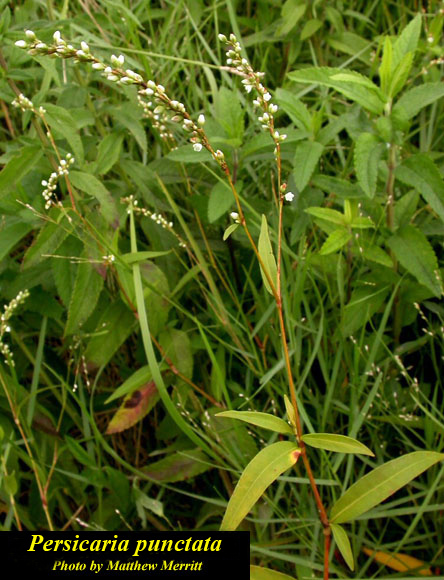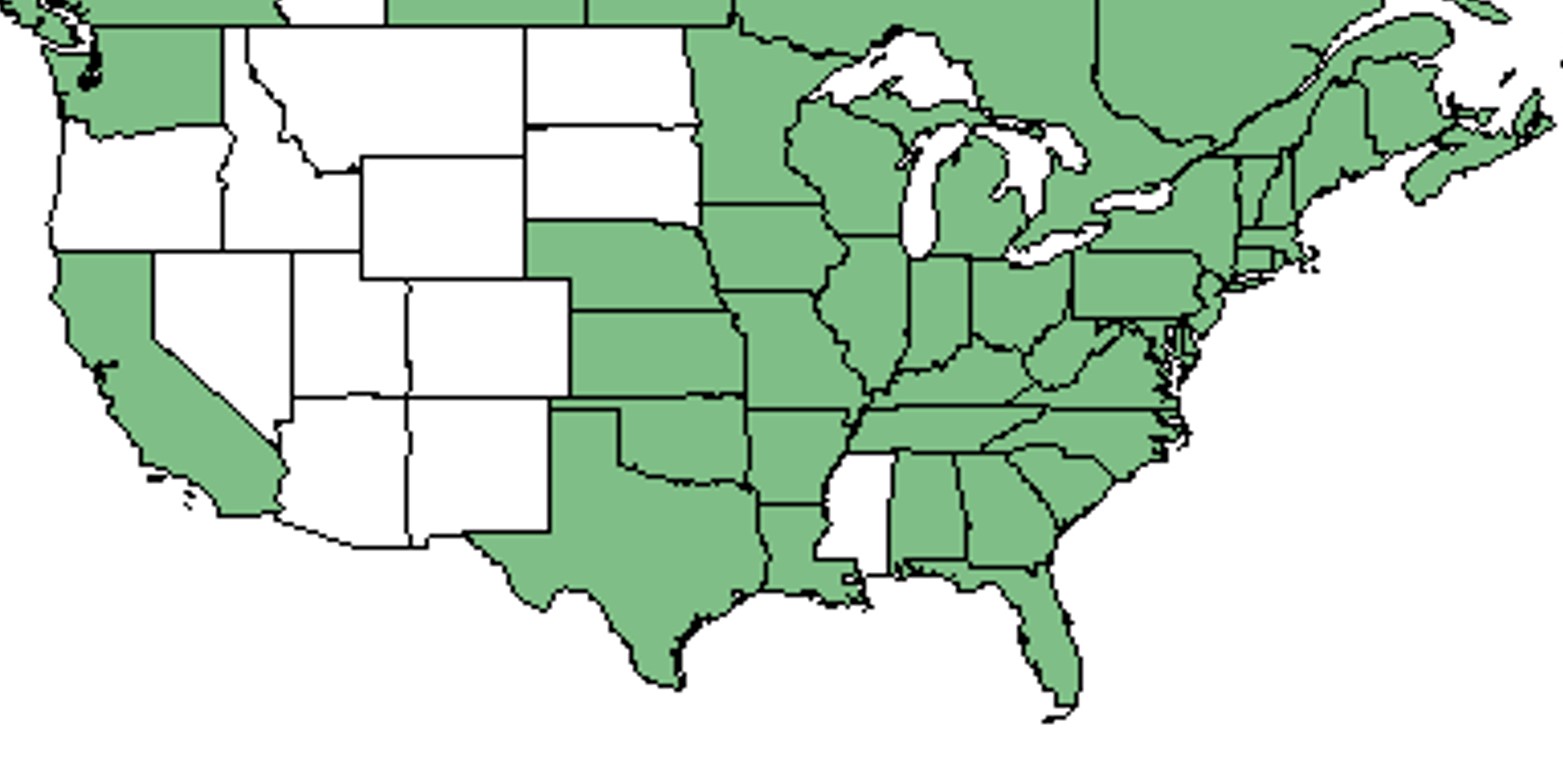Difference between revisions of "Persicaria punctata"
Krobertson (talk | contribs) |
Krobertson (talk | contribs) (→Taxonomic notes) |
||
| Line 22: | Line 22: | ||
Synonyms: ''Persicaria punctata'' (Elliott) Small var. ''punctata''; ''Polygonum punctatum'' Elliott; ''Polygonum punctatum'' Elliott var. ''punctatum''; ''Persicaria punctata'' (Elliott) Small var. ''leptostachya'' (Meisner) Small; ''Polygonum punctatum'' Elliott var. ''leptostachyum'' (Meisner) Small; ''Polygonum punctatum'' var. ''parvum'' Marie-Victorin & Rousseau; ''Polygonum punctatum'' Elliott var. ''confertiflorum'' (Meisner) Fassett | Synonyms: ''Persicaria punctata'' (Elliott) Small var. ''punctata''; ''Polygonum punctatum'' Elliott; ''Polygonum punctatum'' Elliott var. ''punctatum''; ''Persicaria punctata'' (Elliott) Small var. ''leptostachya'' (Meisner) Small; ''Polygonum punctatum'' Elliott var. ''leptostachyum'' (Meisner) Small; ''Polygonum punctatum'' var. ''parvum'' Marie-Victorin & Rousseau; ''Polygonum punctatum'' Elliott var. ''confertiflorum'' (Meisner) Fassett | ||
| − | The species name punctata is derived from Latin, meaning dotted. This refers to the dotted glands of the flowers<ref name="friends">[[http://www.friendsofthewildflowergarden.org/pages/plants/smartweed_dotted.html]]Plants of the Eloise Butler Wildflower Garden. Accessed: February 20, 2016</ref> | + | The species name punctata is derived from Latin, meaning dotted. This refers to the dotted glands of the flowers.<ref name="friends">[[http://www.friendsofthewildflowergarden.org/pages/plants/smartweed_dotted.html]]Plants of the Eloise Butler Wildflower Garden. Accessed: February 20, 2016</ref> |
| − | There are three varieties which include: ''Persicaria punctata var. robustior, P. punctata var. ecilliata'', and ''P. punctata var. tacubayana''<ref name="cabi">[[http://www.cabi.org/isc/datasheet/119608]]Accessed: February 20, 2016</ref> | + | There are three varieties which include: ''Persicaria punctata var. robustior, P. punctata var. ecilliata'', and ''P. punctata var. tacubayana.''<ref name="cabi">[[http://www.cabi.org/isc/datasheet/119608]]Accessed: February 20, 2016</ref> |
==Description== | ==Description== | ||
Revision as of 13:46, 18 August 2016
| Persicaria punctata | |
|---|---|

| |
| Photo by Matthew Merritt, Atlas of Florida Vascular Plants | |
| Scientific classification | |
| Kingdom: | Plantae |
| Division: | Tracheophyta- Vascular plants |
| Class: | Magnoliopsida – Dicotyledons |
| Order: | Caryophyllanae |
| Family: | Polygonaceae |
| Genus: | Persicaria |
| Species: | P. punctata |
| Binomial name | |
| Persicaria punctata (Elliott) Small | |

| |
| Natural range of Persicaria punctata from USDA NRCS Plants Database. | |
Common name: Dotted Smartweed
Contents
Taxonomic notes
Synonyms: Persicaria punctata (Elliott) Small var. punctata; Polygonum punctatum Elliott; Polygonum punctatum Elliott var. punctatum; Persicaria punctata (Elliott) Small var. leptostachya (Meisner) Small; Polygonum punctatum Elliott var. leptostachyum (Meisner) Small; Polygonum punctatum var. parvum Marie-Victorin & Rousseau; Polygonum punctatum Elliott var. confertiflorum (Meisner) Fassett
The species name punctata is derived from Latin, meaning dotted. This refers to the dotted glands of the flowers.[1]
There are three varieties which include: Persicaria punctata var. robustior, P. punctata var. ecilliata, and P. punctata var. tacubayana.[2]
Description
A description of Persicaria punctata is provided in The Flora of North America.
"Annuals or perennials with lanceolate to elliptic leaves. Leaf base cuneate; ocreae with or without cilia. Flowers in racemes arranged paniculately at the apices of stems and branches. Sepals not, or only slightly enlarged in fruit. Nutlets trigonous, biconvex or lenticular." [3]
"Annual or rhizomatous perennial with erect, terete, glabrous or short-strigose stems. Leaves glabrous to short-strigose, 6-15 cm long, 1-3 cm wide, tapered to petioles 2-20 mm long; ocreae strigose, 1-2 cm long, cilia 1-8 mm long. Racemes straight or arching, densely to very loosely flowered. Calyx white or greenish, rarely tinged with red or pink, conspicuously glandular-punctate. Nutlets black, glossy, trigonous or biconvex, 2.5-3 mm long." [3]
Distribution
P. punctata is found throughout most of the United States, it is one of the only native species of Persicaria. It is introduced instead of being native in Idaho, Montana, Colorado, Utah, Wyoming, and Hawaii[4].
Ecology
Habitat
P. punctata is found in wet areas such as floodplain forests, swamps, seeps, pond shores, and drainage ditches[5]. In the Coastal Plain in Florida, P. punctata has been found in wet margins of wax myrtle thickets. [6] It prefers full to partial sun in mucky soil rich in organic matter and will tolerate shallow standing water[5].
Phenology
The blooming period occurs summer to fall and last around 1 to 2 months [5]. It has been observed blooming in September. [6]
Seed dispersal
The seeds are not adapted for dispersal other than floating in water, however, it is postulated to be transported by mud on the feet of water birds[2].
Use by animals
The seeds are eaten by ducks and various songbirds[5].
Conservation and management
Cultivation and restoration
Historically, the Chippewa used the leaves and flowers to treat stomach pain, and the Houma used roots to treat joint pain[7].
Photo Gallery
Persicaria punctata flowers Photo by Matthew Merritt, Atlas of Florida Vascular Plants
References and notes
- ↑ [[1]]Plants of the Eloise Butler Wildflower Garden. Accessed: February 20, 2016
- ↑ 2.0 2.1 [[2]]Accessed: February 20, 2016
- ↑ 3.0 3.1 Radford, Albert E., Harry E. Ahles, and C. Ritchie Bell. Manual of the Vascular Flora of the Carolinas. 1964, 1968. The University of North Carolina Press. 409-410. Print.
- ↑ [[3]] Wildflowers of the United States. Accessed: February 20, 2016
- ↑ 5.0 5.1 5.2 5.3 [[4]]Illinois Wildflowers. Accessed: February 20, 2016
- ↑ 6.0 6.1 Florida State University Robert K. Godfrey Herbarium database. URL: http://herbarium.bio.fsu.edu. Last accessed: November 2015. Collectors: Cecil R. Slaughter. States and Counties: Florida: St. Johns, Volusia. Compiled by Tall Timbers Research Station and Land Conservancy.
- ↑ [[5]]Go Botany. Accessed: February 20, 2016
